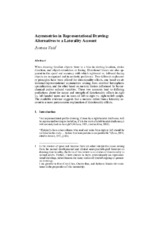| dc.creator | Vaid, Jyotsna | |
| dc.date.accessioned | 2017-02-11T23:24:16Z | |
| dc.date.available | 2017-02-11T23:24:16Z | |
| dc.date.issued | 2011 | |
| dc.identifier.citation | Vaid, J. (2011) Asymmetries in representational drawing: Alternatives to a laterality account. In T.W. Schubert and A. Maass (Eds.), Spatial dimensions of social thought (pp. 23-255). Berlin: Mouton de Gruyter. | en |
| dc.identifier.uri | https://hdl.handle.net/1969.1/158799 | |
| dc.description.abstract | When drawing familiar objects there is a bias in starting location, stroke direction, and object orientation or facing. Directional biases are also apparent in the speed and accuracy with which rightward vs. leftward facing objects are recognized and in aesthetic preference. Two different explanatory principles have been offered for directionality effects, one based on attentional/
representational asymmetries arising from cerebral hemispheric specialization, and the other based on motoric factors influenced by biomechanical and/or cultural variables. These two accounts lead to differing predictions about the nature and strength of directionality effects in right vs. left-handed users and in users of left-to-right vs. right-to-left scripts. The available evidence suggests that a motoric rather than a laterality account is a more parsimonious explanation of directionality effects. | en |
| dc.language.iso | en | |
| dc.publisher | Mouton de Gruyter | |
| dc.subject | script directionality | en |
| dc.subject | reading direction | en |
| dc.subject | drawing | en |
| dc.subject | object facing biases | en |
| dc.subject | cerebral laterality | en |
| dc.subject | Urdu | en |
| dc.subject | handedness | en |
| dc.subject | biomechanical | en |
| dc.subject | spatial biases | en |
| dc.subject | embodied cognition | en |
| dc.title | Asymmetries in representational drawing: Alternatives to a laterality account | en |
| dc.type | Book chapter | en |
| local.department | Psychology | en |


